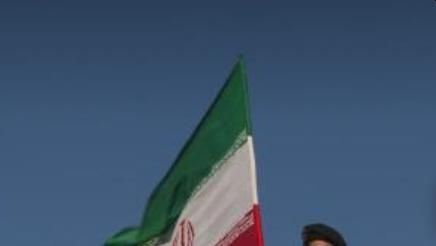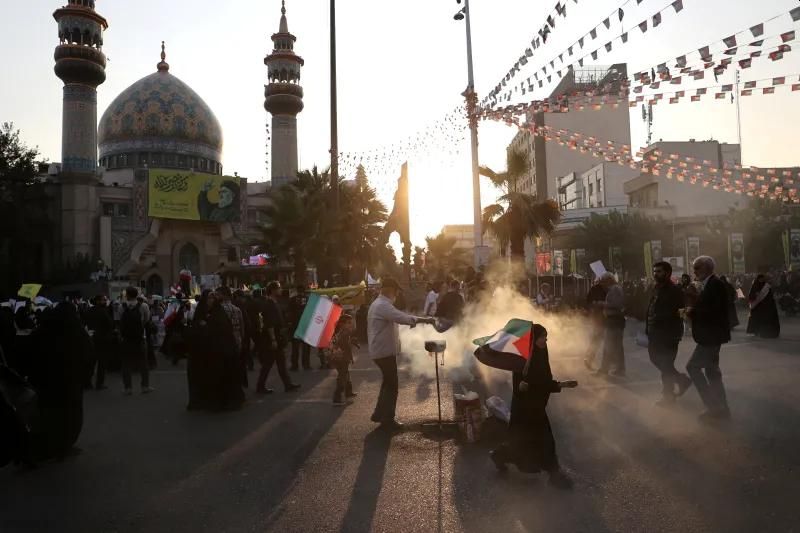By Eric Vandenbroeck and co-workers
Iran’s Year Of Living Dangerously
Over four decades, to
preserve itself, project regional influence, and deter adversaries, the Islamic
Republic of Iran has invested in three projects: funding and arming a network
of nonstate allies; developing ballistic missiles that can reach its rivals;
and launching a nuclear program that can be either dialed down to deliver
economic benefits or dialed up to deliver a nuclear weapon. Setbacks to the
first, mixed results from the second, and uncertainty over the third have
increasingly called this strategy into question.
After Hamas’s
October 7, 2023, attack on Israel, groups in the Iranian-backed “axis of
resistance” quickly mobilized on multiple fronts. In Yemen, the Houthis’
missiles and drones menaced maritime traffic in the Red Sea. In Iraq and Syria, militias launched drones and rockets at U.S.
forces. And in Lebanon, Hezbollah ramped up
cross-border fire into Israel. As Israel waged its military campaign in Gaza,
Israel also sought to douse Iran’s ring of fire, including by targeting Islamic
Revolutionary Guard Corps personnel. In April, an Israeli strike on an Iranian
consular facility in Damascus—which the leadership in Tehran considered a
direct hit on sovereign territory—killed several of the IRGC’s senior
commanders. In response to the mounting losses of IRGC officers
in Lebanon and Syria, Tehran, for the first time, mounted a direct
military attack against Israel. Iran indirectly telegraphed its strike in
advance to the United States, rendering the barrage of drones and missiles
largely ineffective. But Iran’s leaders
nonetheless declared their attack a success.

The April strike, dubbed
Operation True Promise, may have set a precedent in Israel and Iran’s
long-standing rivalry, yet it did little to strengthen deterrence for Tehran.
Israel quickly responded with a surgical strike against an air-defense facility
near Isfahan, exposing the IRGC’s vulnerabilities not far from multiple nuclear
facilities and deterring Tehran, at least temporarily, from another direct
strike on Israel. Iran’s government played down the incident. But in late
July, Iran’s vulnerability was further exposed by an Israeli operation it could
not so easily dismiss: the killing of the Hamas leader Ismail Haniyeh while he
was in Tehran for the inauguration of Iranian President Masoud Pezeshkian.

This time, and
despite fierce rhetoric, the regime held its fire. A U.S.‒led push to nail down
a cease-fire in Gaza provided one stated rationale, as did warnings to the new
Iranian government that its efforts to improve relations with the West would be
dented before they could be tested. A surge in U.S. warships and fighter jets
to the region, and concerns that Israel would retaliate with overwhelming force
against an Iranian response, also likely tipped the scales in Tehran against
further action.
Yet it would prove a
reprieve. The Gaza negotiations made no apparent progress toward a
cease-fire, while Israel began to ramp up operations on its northern front
against Hezbollah—not just the closest of Iran’s allies but also the one whose
military capacities Tehran had done the most to bolster as part of an insurance
policy against an attack on its own soil. A September 17 operation triggering
explosions in thousands of pagers used by Hezbollah cadres was the start of a
blitz that, in less than two weeks, killed some 16 top Hezbollah commanders, as
well as its chief, Hassan Nasrallah. Israel’s strikes on Hezbollah were notable
for both the intelligence capacities and the military capabilities they
revealed, including an ability to penetrate internal communications and track
the group’s operatives. Already on the receiving end of more than a few Israeli
covert operations in the past, including against nuclear sites and personnel,
Tehran may no longer believe itself to be immune to such Israeli operations either.

Iran’s leaders likely
saw themselves as having only bad choices: stand by and lose both what was left
of its diminishing deterrence as an adversary and credibility as an ally, or
enter the fray once more despite the risk of an even greater counterstrike from
Israel. With little forewarning, it launched its second direct attack on Israel
on October 1, which the U.S. Department of Defense estimated to be double the
size of the April attack. (The 180 ballistic missiles caused some damage at two
Israeli military air bases, which may raise concerns about the potential of
future Iranian attacks, although both the Israeli military and senior U.S.
officials judged their impact to be operationally “ineffective.”)
That attack, which
Tehran dubbed Operation True Promise 2, was a far bigger gamble than its April
namesake, all but inviting a response at a time when Israelis (and some senior
officials in Washington) are bullish about the speed and ingenuity with which
Israel has degraded Hezbollah’s leadership and military capacities. U.S.
President Joe Biden has publicly counseled Israel against attacking Iran’s
nuclear and oil facilities. At the same time, ongoing military campaigns in
both Gaza and Lebanon may slightly temper an Israel retaliation that Israeli
Defense Minister Yoav Gallant has foreshadowed as “lethal, precise, and
especially surprising.” Yet even if this round of exchanges can be contained,
it may, once more, prove to be a brief respite.
With its proxies
enfeebled, the failure of Iran’s second missile barrage to do significant damage,
and its adversaries’ superior military and intelligence capacities, the Islamic
Republic’s hand has undoubtedly been weakened. Unsurprisingly, a growing
segment within the system’s political class and propaganda networks is more
loudly vocalizing calls that had previously been whispering: shedding the
nuclear program’s ostensibly peaceful pretense and moving toward weaponization
as the ultimate deterrent.
CIA Director Bill Burns recently estimated that Iran’s
breakout time—the amount of time needed to enrich enough fissile material for a
single bomb to weapons grade—at “a week or a little more.” It would then take
only a few more months to fashion it into a deliverable weapon. Given the
advanced nature of Iran’s nuclear activities, as well as setbacks on the other
legs of its strategic triad, the regime has both motive and opportunity to make
a decision it has long deferred. For three reasons, however, that step could
compound rather than resolve its problems.
Iranians protesting Israel in Tehran, October 2024

The first is that
even if Iran’s nuclear facilities are spared from an initial Israeli
retaliation, a dash toward weaponization, which Burns assessed would be
detected “relatively early on,” could well be treated by Israel and the United
States as a casus belli, putting key Iranian nuclear sites squarely in Israeli
and potentially U.S. crosshairs. Although Israel can inflict damage on Iran’s
highly fortified and widely dispersed nuclear facilities, only the United
States can set Iran’s program back significantly.
A second problem has,
ironically, been underscored by the Iranian government’s actions. The case for
pursuing a nuclear weapon as the ultimate deterrent has been undermined by
Tehran’s willingness to carry out conventional attacks against not one but two
nuclear-armed powers this year: Israel and Pakistan. In other words, if Iran’s
objective is not just to guarantee regime survival but also to dissuade
adversaries from counterstrikes, it seems peculiar to expect improved
deterrence by means that have failed to deter Tehran itself.
The third challenge
that would come from moving toward building a nuclear arsenal is the likely
collapse, at least in the near to medium term, of any prospect of using the
nuclear program as a point of leverage to gain relief from international
sanctions. As recently as late September, the Pezeshkian government was testing
the waters with Western powers on the potential parameters of renewed
engagement. If Tehran developed nuclear weapons, the European participants in
the 2015 nuclear agreement (France, Germany, and the United Kingdom) would
almost certainly reconsider those tentative contacts. Instead, they would take
the lead in restoring UN sanctions lifted under that deal and
reclassifying the Islamic Republic as a threat to international security under
the UN Charter.
For Iran’s leaders,
the sudden exposure of its vulnerabilities may be fueling an increased appetite
for risk—risks that they may hope will compensate for mounting failures and
prevent future ones. Yet a change to its nuclear doctrine is unlikely to resolve
the Islamic Republic’s strategic dilemmas. A move toward a nuclear weapon would
likely bring conflict in the short term. In the longer term, even obtaining the
ultimate deterrent would not necessarily safeguard the regime against enemies
at home and abroad, who will continue to exploit its inferior intelligence,
weakness in conventional weapons, failing economy, and eroding legitimacy.
For updates click hompage here